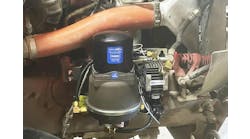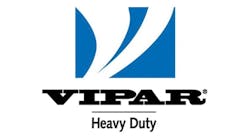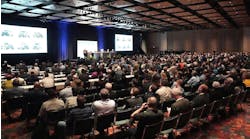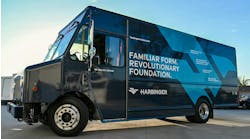Latest from Distributors, Upfitters
Truck frames and side rails are the basic ingredients to manufacturing a commercial vehicle. Yet few of us understand the frame manufacturing process, the terminology of side rail engineers, or the nuances of modifying side rails. That was a topic of conversation when truck equipment distributors gathered in St Louis, Missouri, February 23-25, to attend the 36th annual NTEA convention and exhibition.
Attendees had an opportunity to learn about the side rail design, manufacturing, and the terminology used in describing them. Gerford (Red) Carver, an engineering consultant with over 30 years' experience with companies such as A O Smith and Midland-Ross Frame, presented the day-long workshop. Carver also served as chairman of the Society of Automotive Engineers Heavy-Truck Committee.
Side Rail Assembly
Side rail manufacturing is a specialized business, Carver said. "In most cases, side rails are manufactured from coil steel through a very laborious process." Carver explained that the steel coils are brought unrolled and then cut to the width of the planned side rail. Material thickness ranges from 1/4" and beyond, depending on the desired thickness of the side rail needed. The pieces, now in the desired width, are cut to correct length.
At this point, a piercing machine sets the componentry attachment holes in the side rail member. "At one time, truck manufacturers used to put as many holes in the rail as they could. This way the rails could be used for lots of different front-end setups, or different style tanks," Carver said. "Now, the process is to blank as needed for specific componentry."
Forming the channel is a one-step process. Straight channels are manufactured by a process called roll-forming or by press-forming. In both processes, the purpose is to bring the sides of the blank into a basic C formation. Specially contoured or drop-frame side rails are press formed. Any final metal trimming of the channel is done at this time.
The rails are then heat treated and shot blasted to add strength. "Heat can either be gradually introduced to the rail, or a blast furnace method can be used. A quench bath and shot blasting finish the heat treatment process."
Side Rails Define the Chassis
The best key to understanding side rails and the job they perform can be found by understanding the terminology, said Carver. "People in our industry use many of the terms interchangeably when that's not really appropriate. It's important to fully understand the differences and the terminology of side rails."
The terms section modulus and resistance bending moment are on just about every federal, state, local, and school district bid sheet. But what do they really mean? As explained by Carver, section modulus is a measure of a frame's strength based solely upon the height, width, thickness, and configuration of the side rails at the area of maximum stress. "This term is meaningless when it is used to indicate strength without specifying the properties or material of the side rail," Carver said. "Cardboard and steel, for example, have the exact same dimensions and will have the same section modulus."
In today's world, to require that a side rail meet a certain section modulus number for comparison purposes is not unusual. However, that assumes that both rails are made from steel, or at least the same material. In the not too distant future, side rails or other structural members might be made out of different material. In these cases, a section modulus number that the customer requires might be met by the use of composite or lightweight aluminum instead of steel.
"The second definition that upfitters must understand is called the resistance bending moment (RBM)," Carver said. RBM is a calculation used to compare frames that have different characteristics. RBM is calculated by using the section modulus number and multiplying it by the known yield strength.
Every material has a yield strength that can be mathematically defined. For a side rail, the yield strength is the ability of the metal to return to its original shape after removal of a maximum load. It is calculated in pounds per square inch.
"All of these terms and calculations are used to determine other important information that pertains to side rails," Carver said. "The calculations are complicated. I use a special computer program for them; however, the main goal is to gain enough information to make a side rail that meets the end user's strength requirements while meeting the deflection limitations, and provide that rail in a cost effective and weight sensitive way."
Upfitters should ensure that the body installation will not place the side rails in an unsustainable position. "This situation can easily happen if an upfitter extends the wheelbase and then adds a body that would put excessive strain on the side rails," Carver said. Examples are dump bodies being added to former over-the-road tractors. Also, derricks that are mounted on chassis not originally intended for this use can quickly add unsustainable pressures to the side rails of a vehicle, Carver noted.
Types of Failures
In the order of highest failure levels, fatigue, static bending, deflection, corrosion, brittle fracture, and buckling failure will damage side rails. Many of these problems fit into the category of damage caused by load shock, poor sales engineering to fit a specific application, or an error in the manufacturing engineering.
Nevertheless, two types of simple and solvable problems can haunt the upfitter: Fatigue induced by improper side rail modification and corrosion caused by poor assembly practices.
Fatigue fractures usually originate at a stress concentration point, Carver said. "The problem would most likely start as a hole or a poorly performed welding procedure." A crack or fatigue of the metal will start at a right angle of the stressed point and continue until arrested or total failure ensues.
"Welding on a heat treated frame is catastrophic," Carver said. Heat damage will occur and the fatigue strength will be greatly reduced. "The damage is not always evident immediately after welding. It may appear after the unit has been returned to service for some time." But the damage is traceable back to the point of origin, the welding done on a heat-treated frame.
"Many upfitters are unaware that they can cause corrosion," Carver said. Leaving excessive burr remains on drilled holes can possibly cause loss of bolt tension and subsequent corrosion if the unit is placed in a harshly corrosive environment. Upfitters have been found liable because of side rail failures on snow removal equipment and some types of construction equipment, said Carver.
"It can start anywhere, and a good place to start is between an inverted L and the main side rail," Carver said. That's not the upfitter's fault, Carver added. "Sometimes metal shavings can get between the rails during assembly and create space for road salts. It may be worthwhile to advise customers that the upfitter isn't assuming future liability for this type of damage."
Another issue for the upfitter is adding holes to a side rail. According to Carver, a small clip-hole drilled in a frame can cause greater problems than a properly drilled 5/8" or larger frame fastener.
Holes should be added in the neutral area of the frame or the mid-section. "Any hole placed near the webbing part of the side rail is apt to cause rail failure," said Carver.
Carver noted that in drilled versus pierced holes, the pierced hole seemed to have a somewhat better cyclical rate than the drilled holes. Carver recommended that bolts should not be cut off by using a cutting torch, which is a common upfitters practice. ♦









